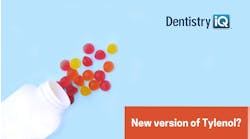Oral health is not just about a bright smile; it is closely linked to overall well-being. Beyond brushing and flossing, certain dietary choices can contribute to strong teeth, healthy gums, and fresh breath. Here are some essential tips for achieving better oral health and a healthier body, including healthy foods and a new antibacterial treatment.
You may also be interested in … How antibacterial photodynamic therapy improves oral health in patients with Sjögren’s syndrome
10 foods to focus on for oral-systemic health
Water: Staying hydrated is essential for saliva production. Saliva is an important defense mechanism as it helps cleanse the mouth of bacteria and food particles. Adults should drink at least 1–1.5 liters per day.1
Dairy products: Dairy products such as milk, cheese, and yogurt are rich in calcium and phosphorus, which help strengthen tooth enamel. In addition to lactose, calcium, and phosphorus, milk proteins have also been shown to positively affect dental health. Caseins are the most abundant group of proteins in bovine milk and account for approximately 80% of the total milk protein.2
Crunchy fruits and vegetables: Consuming foods with fiber help keep your teeth and gums clean, according to the American Dental Association. Foods such as apples, carrots, celery, and cucumbers are high in fiber and require chewing, which stimulates saliva production thus helping to maintain a healthy smile. According to studies, fruit consumption is also inversely associated with periodontal disease.3
Leafy greens: Spinach, kale, and other leafy greens are rich in vitamins and minerals such as calcium, folic acid, and B vitamins that promote oral health.4
Lean proteins: Foods such chicken, turkey, and lean cuts of beef contain phosphorus, which is essential for strong teeth and bones. Lean proteins are rich in essential amino acids, the building blocks of proteins. These amino acids are vital for the growth, repair, and maintenance of gum tissue.5
Nuts and seeds: These provide healthy fats, protein, and minerals such as calcium and phosphorus that are beneficial for oral health.
Green tea: Green tea is one of the most popular beverages in the world, and it has received growing attention due to its many scientifically proven beneficial effects on human health. Green tea contains antioxidants called catechins that can help reduce inflammation in the mouth and fight bacteria.6
Xylitol: This natural sweetener has properties that reduce levels of Streptococcus mutans bacteria in dental plaque and saliva. S. mutans is the main cause of dental decay. Chewing sugar-free gum with xylitol can stimulate saliva production and help reduce the risk of tooth decay. The recommended daily dose of xylitol for dental caries prevention is 6–10 grams per day.7,8
Lingonberries: The lingonberry (Vaccinium vitis-idaea L.) is a low-bush wild plant found in the northern hemisphere. The berries are used in traditional medicine in Finland to treat oral yeast infections. Lingonberries contain compounds similar to cranberries that may help prevent the adhesion of bacteria to the teeth, reducing the risk of cavities. Lingonberries are a promising natural approach with their beneficial antioxidant, anti-inflammatory, antiproteolytic, anticancerous, and antimicrobial effects on oral and general health.8
Unsweetened yogurt: Eating yogurt, particularly plain or low-sugar yogurt, can be beneficial for oral health and may help in controlling bad breath. Yogurt is a source of probiotics, which are beneficial bacteria that can help balance the oral microbiome. An imbalanced oral microbiome can contribute to bad breath (halitosis). The best yogurts for dental health are plain and Greek yogurts, because they often contain the highest number of probiotics. Yogurt is also high in calcium, which helps keep teeth strong.9
You may also be interested in … Oral-systemic health: Effects on athletic performance
Raising oral hygiene to the next level
While some foods and beverages can support oral health, the real secret to a strong body and a healthy smile lies in daily oral care. Research shows that oral bacteria are linked to many chronic diseases in the body. In addition to heart disease, oral disease has been linked to lung disease, diabetes, and metabolic problems—even the development of certain types of cancer and pregnancy complications such as premature birth and low birth weight.
Dr. Tommi Pätilä, a specialist in cardiac and organ transplant surgery at Helsinki University Hospital (HUS) New Children’s Hospital, says, “It is estimated that up to two out of three people over the age of 30 in Finland suffer from periodontitis. When oral hygiene is lacking, harmful bacteria can thrive and potentially enter the bloodstream, increasing the risk of infection and inflammation in other parts of the body.”
Studies have shown a bidirectional relationship between diabetes and gum disease. Poorly controlled diabetes can lead to increased susceptibility to infections, including periodontal disease. On the other hand, gum disease can make it more difficult for people with diabetes to control their blood sugar levels.10 “Oral bacteria that remain on tooth surfaces and in gum pockets spread throughout the body when teeth are brushed and food is chewed. Even asymptomatic oral conditions can affect the health of the whole body,” Dr. Pätilä explains.
Controlling oral biofilm, or plaque, is critical in preventing oral diseases such as gingivitis, periodontitis, and tooth decay. Meticulous brushing and flossing combined with regular dental checkups are essential for maintaining a healthy mouth and overall wellness. However, mechanical oral hygiene methods are not always sufficient because they leave residual plaque. In fact, one study shows that even a high-quality electric toothbrush removes only about 65% of the harmful bacteria in the mouth.11
The antibacterial Lumoral treatment, developed by Finnish scientists, helps when traditional oral hygiene methods are not enough. Lumoral slows down the formation of plaque while helping to enhance the effects of mechanical oral hygiene and significantly improving the results of professional oral care in a preventive way. The effect of the treatment has been demonstrated in studies by a significant reduction in gum bleeding and inflammatory biomarkers, as well as a reduction in deep gingival pockets. Lumoral is a targeted treatment, which means that the healthy bacterial flora in the oral cavity are preserved, and, simultaneously, gingival inflammation is controlled.12
Editor’s note: This article first appeared in Through the Loupes newsletter, a publication of the Endeavor Business Media Dental Group. Read more articles and subscribe to Through the Loupes.
References
- Fedorciw R. The oral health benefits of drinking water. Smile Drs. July 23, 2021. https://smiledrs.com/the-oral-health-benefits-of-drinking-water/
- Shkembi B, Huppertz T. Impact of dairy products and plant-based alternatives on dental health: food matrix effects. Nutrients. 2023;15(6):1469. doi:10.3390/nu15061469
- Nielsen SJ, Trak-Fellermeier MA, Joshipura K, Dye BA. Dietary fiber intake is inversely associated with periodontal disease among US adults. J Nutr. 2016;146(12):2530-2536. doi:10.3945/jn.116.237065
- Foods that boost your oral health. Progressive Periodontics. February 22, 2022. https://www.myperiopro.com/about-us/blog/2022/february/foods-that-boost-your-oral-health/
- Jayasinghe TN, Harrass S, Erdrich S, King S, Eberhard J. Protein intake and oral health in older adults–a narrative review. Nutrients. 2022;14(21):4478. doi:10.3390/nu14214478
- Chatterjee A, Saluja M, Agarwal G, Alam M. Green tea: a boon for periodontal and general health. J Indian Soc Periodontol. 2012;16(2):161-167. doi:10.4103/0972-124X.99256
- Nayak PA, Nayak UA, Khandelwal V. The effect of xylitol on dental caries and oral flora. Clin Cosmet Investig Dent. 2014;6:89-94. doi:10.2147/CCIDE.S55761
- Pärnänen P, Lähteenmäki H, Tervahartiala T, Räisänen IT, Sorsa T. Lingonberries–general and oral effects on the microbiome and inflammation. Nutrients. 2021;13(11):3738. doi:10.3390/nu13113738
- Ferrazzano GF, Cantile T, Quarto M, Ingenito A, Chianese L, Addeo F. Protective effect of yogurt extract on dental enamel demineralization in vitro. Aust Dent J. 2008;53(4):314-319. doi:10.1111/j.1834-7819.2008.00072.x
- Heikkilä P, Niskanen L, But A, Sorsa T, Haukka J. Oral health associated with incident diabetes but not other chronic diseases: a register-based cohort study. Front Oral Health. 2022;3:956072. doi:10.3389/froh.2022.956072
- Aggarwal N, Gupta S, Grover R, Sadana G, Bansal K. Plaque removal efficacy of different toothbrushes: a comparative study. Int J Clin Pediatr Dent. 2019;12(5):385-390. doi:10.5005/jp-journals-10005-1669
- Pakarinen S, Saarela RKT, Välimaa H, et al. Home-applied dual-light photodynamic therapy in the treatment of stable chronic periodontitis (HOPE-CP)–three-month interim results. Dent J (Basel). 2022;10(11):206. doi:10.3390/dj10110206







